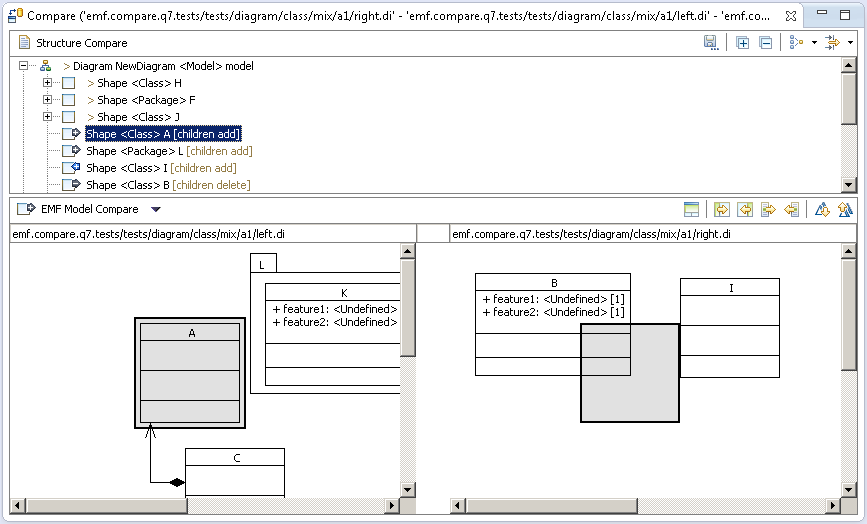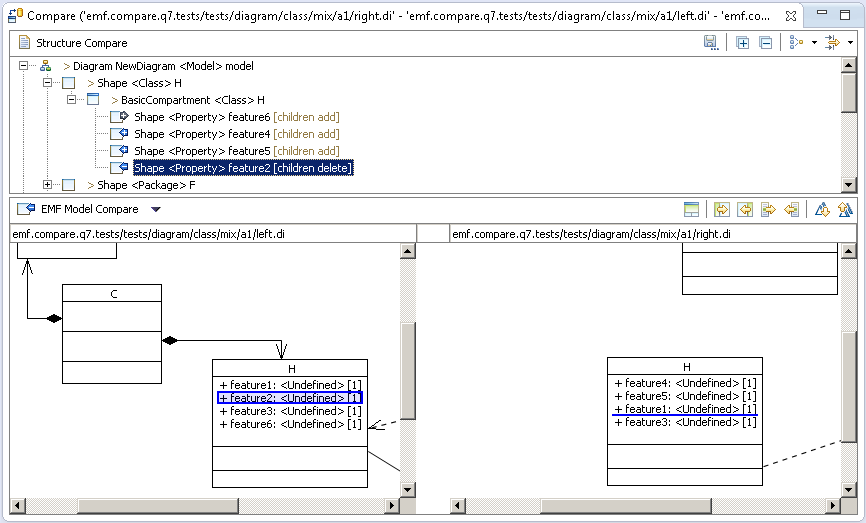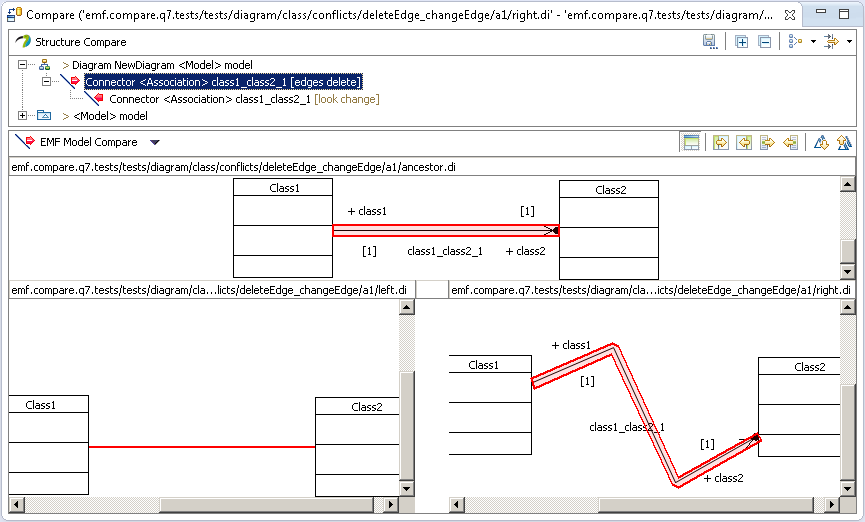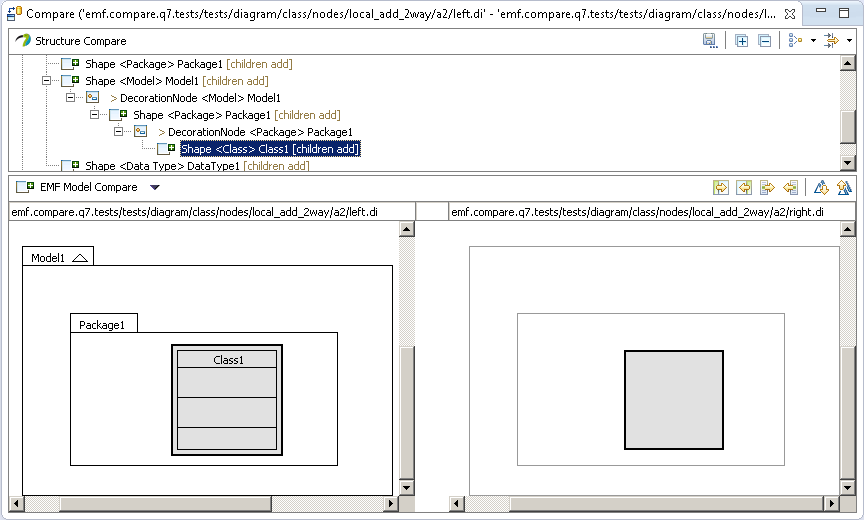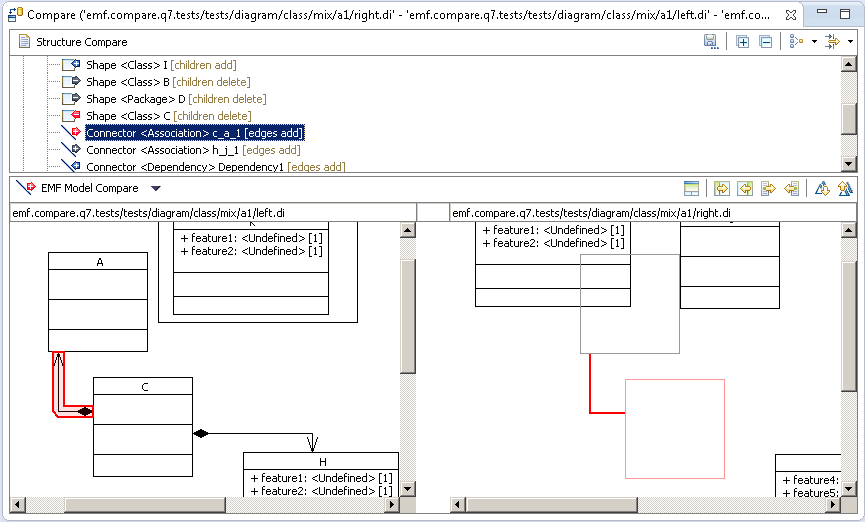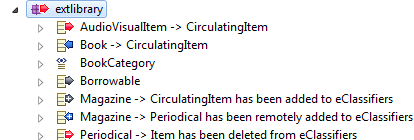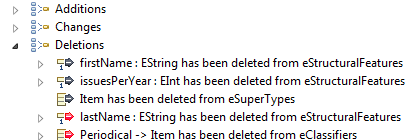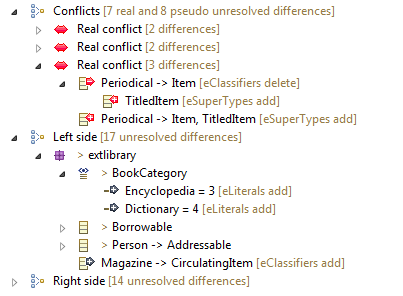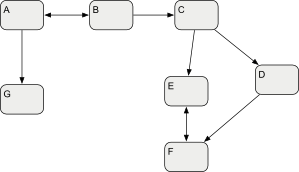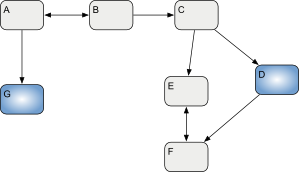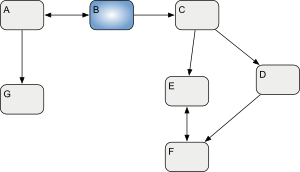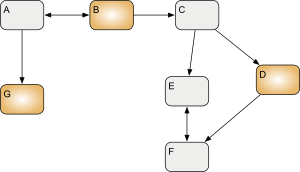Notice: this Wiki will be going read only early in 2024 and edits will no longer be possible. Please see: https://gitlab.eclipse.org/eclipsefdn/helpdesk/-/wikis/Wiki-shutdown-plan for the plan.
Difference between revisions of "EMF Compare/Release Review/2.1.0"
(→Graphical comparison) |
(→Graphical comparison) |
||
| Line 26: | Line 26: | ||
2.1 re-introduces the graphical comparison with a much more complete support on all aspects : comparison, visualization, merging... Here are a few key points of these enhancements : | 2.1 re-introduces the graphical comparison with a much more complete support on all aspects : comparison, visualization, merging... Here are a few key points of these enhancements : | ||
| − | ; | + | ; Uses the same formalism as the semantic comparison: color, interest areas and place-holders, highlighting on selection. |
:* Add node in local: | :* Add node in local: | ||
| Line 37: | Line 37: | ||
:: [[Image:Conflict.PNG]] | :: [[Image:Conflict.PNG]] | ||
| − | ; | + | ; Displays one difference at a time (on double-click) but with its context: |
:* Cascading additions: | :* Cascading additions: | ||
Revision as of 10:37, 21 May 2013
Contents
- 1 Kepler Release Review - EMF Compare 2.1
- 1.1 Release Highlights
- 1.2 Quality of APIs
- 1.3 End of Life Issues
- 1.4 Commiter Diversity
- 1.5 IP Issues
- 1.6 Non-Code Aspects
- 1.7 APIs
- 1.8 Documentation
- 1.9 Bugzilla
- 1.10 Tool usability
- 1.11 Standards
- 1.12 UI Usability
- 1.13 Communities
- 1.14 Committer Changes
- 1.15 Schedule
- 1.16 Project Plan
- 1.17 Legal Notices
Kepler Release Review - EMF Compare 2.1
Laurent Goubet (laurent.goubet@obeo.fr)
Release Review : May 21, 2013
Communication Channel : eclipse.modeling.emf newsgroup
Process Documentation : http://www.eclipse.org/projects/dev_process/development_process.php
Project Plan : http://www.eclipse.org/emf/compare/project-info/plan-kepler.xml
Release Highlights
EMF Compare 2.0 was a full overhaul of the design, architecture and code of the project. EMF Compare 2.1 comes to fill the functionality gap between 1.3 and 2.0, especially regarding content matching and graphical comparisons.
New and noteworthy
Content Matching
EMF Compare 2.0 only supported models that presented IDs of some sort : XMI ID, functional ID... 2.1 re-introduces support for other models through a content matching strategy.
By default, EMF Compare will try and match objects through their ID, delegating to the content matcher if none can be found. This can be altered to avoid using identifiers entirely when needed.
Graphical comparison
EMF Compare 1.3 provided basic support for GMF diagram comparisons and difference visualization. This basic implementation was dropped altogether in the 2.0 release as the architecture overhaul made it obsolete.
2.1 re-introduces the graphical comparison with a much more complete support on all aspects : comparison, visualization, merging... Here are a few key points of these enhancements :
- Uses the same formalism as the semantic comparison
- color, interest areas and place-holders, highlighting on selection.
- Displays one difference at a time (on double-click) but with its context
Conflict detection
The conflict detection has been largely revamped in order to properly detect complex conflicts and pseudo conflicts (identical changes on both sides of the comparison are conflicting, but can be auto-merged... and as such are detected as "pseudo" conflicts). This also allows for much better results with extensions such as the UML or GMF specific supports.
Enhanced UI
The comparison UI has been enhanced to provide a much more precise and intelligible information. Among these improvements, the most notable are :
- a number of grouping options
- This feature allows you to group differences together in the structural view according to a set predicate. By default, EMF Compare provides three distinct grouping strategies :
-

- Default : Do not try and group differences together, display them as they were detected.
- By Kind : Group differences by their kind (additions, deletions, moves, changes).
- By Side : Group differences according to their side: left or right and a special group regrouping differences in conflicts with other differences together.
- a comprehensive set of filters
- This features allows you to filter differences out of the structural view according to a set predicate. By default, EMF Compare provides five distinct filters :
-
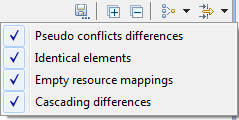
- Pseudo conflicts differences: Filter out all pseudo conflicts differences(only in 3-way comparison). Enabled by default.
- Identical elements : Filter out all identical elements (elements with no differences). Enabled by default.
- Empty Resource Mappings : Filter out all resource mappings with no differences from the view. Enabled by default.
- Cascading differences : Filter out all differences that are contained under differences (except when in conflict). Enabled by default.
- more complete contextual information around the differences
- All differences of containment references are now displayed within the same TreeViewer.
-
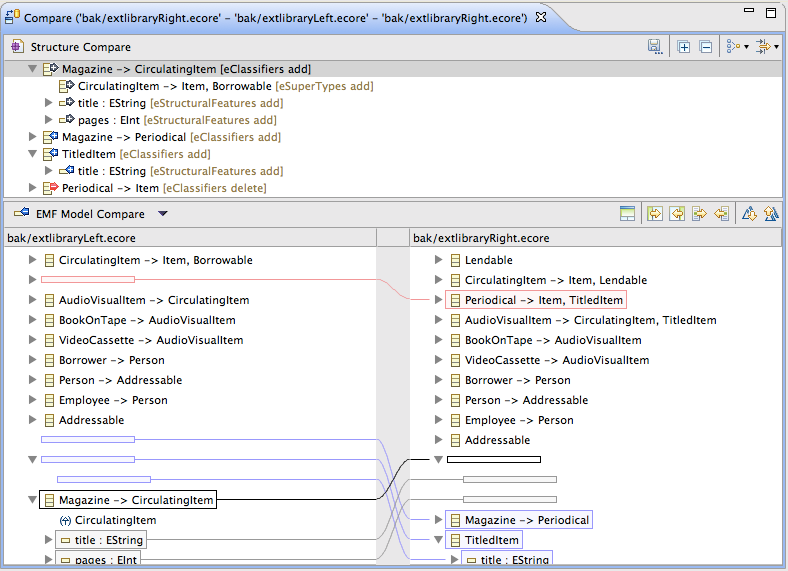
-
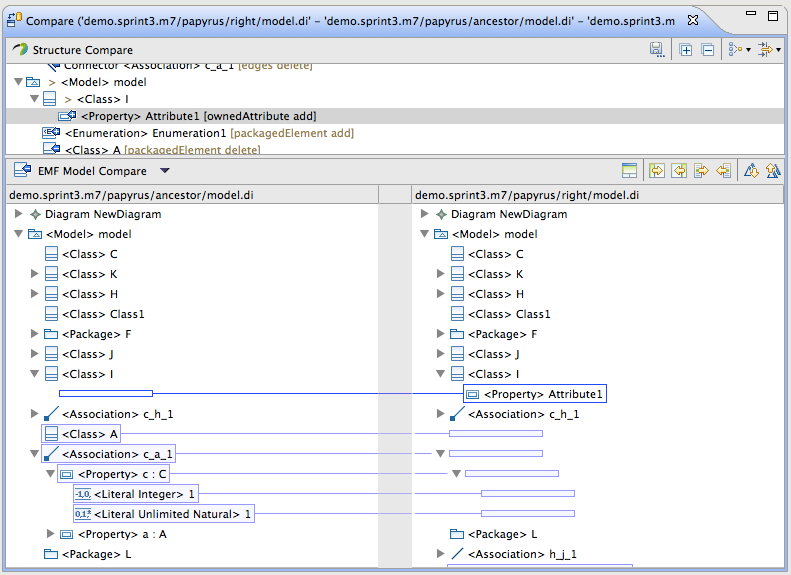
- background comparisons
- All comparisons launched from the UI are now executed as background operations. This will avoid the usual "frozen" Eclipse for long-running comparisons.
- Direct edit
- Textual differences can now be directly edited in the comparison editor for users that would rather use a mix of the left and right values instead of taking one or the other.
Customizable UI
One of the main limitations of the 1.* stream was its "locked" UI. EMF Compare 2.1 introduces a lot of customization options for the visualization of the differences and model elements.
- Users can introduce new filters through the org.eclipse.emf.compare.rcp.ui.filters extension point. Filters can be contributed to either hide or show differences given a predicate.
- New grouping options can be contributed through the org.eclipse.emf.compare.rcp.ui.groups extension point. The groups can be used to group differences together in the "structure" (top half) panel of the comparison UI.
- Label providers can be contributed to override or extend the behavior of the default EMF label providers through the org.eclipse.emf.compare.rcp.ui.accessorFactory extension point. This can be used to change the way elements are displayed in the compare UI, both in the structure (top half) or content (bottom half) panels of the comparison UI.
Minimized Scope
EMF Compare 2.0 introduced the mandatory architecture and API for the project to handle large input models... Yet only provided a default scope which loaded everything in memory and compared the input models as a whole. 2.1 builds upon these APIs to introduce a scoping mechanism capable of treating model fragments as first-class citizens, minimizing the input logical model to the bare minimal while never loading the whole model in-memory unless all of its fragments have changed.
For example, assuming that we need to compare the three following models :
| Origin |
|---|
| Left | Right |
|---|---|
Each of the three sides is an EMF model composed of 7 fragments. Origin is the common ancestor of left and right. The blue-colored fragments are those that actually present differences (so D and G have been modified in the "left" copy while only B has been modified in the "right" copy).
In order to compare these three models together, we would normally need to load all 21 fragments in memory. However, with the help of the synchronization model we can narrow it down to the modified fragments only. What we'll really load, then, are the following fragments for each three sides :
In other words, we are actually only loading 9 fragments out of the initial 21. This amounts to 58% less memory usage if we consider all fragments to be of equal "weight". And this is only for small models; the ratio of saved memory really going up for extremely large models. Of course, all of these objects that we are not loading in memory are all objects that we no longer need to compare, bringing an incredible performance boost along with the memory gain.
API
A number of new APIs have been opened in order to facilitate the programmatic use of EMF Compare and consumption of its output comparison model.
Pretty Printer
The comparison model contains a lot of information, which might be hard to consume or read. 2.1 introduces APIs that will provide more user-friendly descriptions for both differences and matched elements.
For example, here are the results for a given difference :
System.out.println(diff);
- ReferenceChangeSpec{reference=EClass.eSuperTypes, value=EClass@3190dc79 TitledItem, parentMatch=MatchSpec{left=EClass@72b398da Book, right=EClass@675926d1 Book, origin=EClass@28d4ff95 Book, #differences=3, #submatches=5}, match of value=MatchSpec{left=<null>, right=EClass@3190dc79 TitledItem, origin=<null>, #differences=1, #submatches=1}, kind=ADD, source=RIGHT, state=UNRESOLVED}
EMFComparePrettyPrinter.printDifference(diff, System.out)
- value TitledItem has been remotely added to reference eSuperTypes of object Book
Comparison Configuration
Most aspects of the comparison process can be customized before launching the comparison itself. All customizations can be made in a similar way through the EMFCompare class, they will be described in depth on the Developper guide.
For example, replacing the Match engine would be done through
IMatchEngine customMatchEngine = new MyMatchEngine(...); EMFCompare.builder().setMatchEngine(customMatchEngine).build().compare(scope);
Or replacing the Diff engine could be done with
IDiffEngine customDiffEngine = new MyDiffEngine(...); EMFCompare.builder().setDiffEngine(customDiffEngine).build().compare(scope);
Separation of the RCP, IDE and core concepts
EMF Compare 2.1 further enhances the separation of concerns that 2.0 introduced so that the core of the comparison process is all located in a single, fully standalone plugin that does not depend on Eclipse in the least.
Furthermore, all code that does not depend on the IDE has been extracted in "rcp" namespaces, both RCP and RCP UI are in this case, separated themselves in their own isolated plugins.
Mergers extensibility
The mergers have been greatly enhanced since the 1.* stream of EMF Compare, though 2.0 did not allow for easy overriding, replacing or inheriting of the default mergers.
EMF Compare 2.1 solves these concerns by introducing a more flexible merging mechanism, supporting any kind of combination of existing/new/overridden mergers along with a "batch" merging mechanism. Clients can refer to IMerger.Registry for more information on extending the default behavior.
Performance Enhancements
EMF Compare 2.1 introduced a minimized scoping mechanism, which will greatly enhance both the memory footprint and comparison time of all comparisons targetting fragmented models.
Furthermore, both aspects (memory footprint and overall time) have been fully profiled and enhanced for large model comparisons, this makes for a noticeable improvement on all comparisons, whether the input models are fragmented or not.
Quality of APIs
The component lead certifies that the requirements for Eclipse Quality APIs have been met for this release. All non-API code is in "internal" packages.
End of Life Issues
EMF Compare 2.0 made all API from the 1.* stream obsolete. As such, end of life issues only concern the 2.0 as compared with the 2.1 code base.
There are no outstanding issues with the API state of this release. All mehods and classes that face deletion have been marked as deprecated with instructions on how to switch to the new behavior, and will stay in the code base until the next release.
Commiter Diversity
5 active commiters from Obeo
- Cédric Brun (Project Lead)
- Cédric Notot
- Laurent Goubet
- Mikaël Barbero
- Axel Richard
1 inactive commiter from Itemis
- Patrick könemann
IP Issues
The about files and use licenses are in place as per the Guidelines to Legal Documentation.
- CQ 5460 - Google Collections Version: 1.0 https://dev.eclipse.org/ipzilla/show_bug.cgi?id=5460
- CQ 6518 - Guava Version: 10.0.1 https://dev.eclipse.org/ipzilla/show_bug.cgi?id=6518
- CQ 7056 - Guava Version: 11.0.2 https://dev.eclipse.org/ipzilla/show_bug.cgi?id=7056
Large contributions have been made through individual CQs, which can all be consulted from https://dev.eclipse.org/ipzilla/buglist.cgi?component=modeling.emf.compare .
All other contributions (code, documentation, images, etc) have been committed by individuals who are either Members of the Foundation or have signed the appropriate Committer Agreement. In either case, these are individuals who have signed, and are abiding by, the Eclipse IP Policy. The other contributions of the IP log are not significant or are written 100% by employees of the same employer (Obeo) as the Submitting Committer (http://www.eclipse.org/legal/EclipseLegalProcessPoster.pdf).
All contribution Questionnaires have been completed.
The "provider" field of each plugin is set to "Eclipse Modeling Project".
The "copyright" field of each plugin is set to the copyright owner.
Any third-party logos or trademarks included in the distribution (icons, logos, etc) have been licensed under the EPL.
The EMF Compare IP log is located at http://www.eclipse.org/projects/ip_log.php?projectid=modeling.emf.compare
Non-Code Aspects
Continuous Integration
Project is built from the Eclipse hudson instance through Tycho. A nightly is built once a day if the SCM polling sees a change from the last build.
Unit Tests
911 unit tests launched on every build.
Code coverage is about 80% of the core.
Code Quality
Common formatter and compiler configuration used throughout the whole project's plug-ins.
Checkstyle activated on most distinct plug-ins.
Eclemma used on a regular basis to ensure and improve code coverage from the unit tests.
Yourkit java Profiler used on a regular basis to improved performances and avoid bottlenecks.
Findbugs launched on a regular basis to avoid detectable bugs.
Javadoc represents about 40% of the java source code.
An analysis of the code base is available on Ohloh.
APIs
Metamodel definitions and interfaces are considered APIs.
Commitment to provide stand-alone comparison feature (Jar that can be used without Eclipse with minimal to no dependencies towards eclipse core Jars).
Non-API classes are separated from the exposed API through an "internal" namespace.
Non-API packages are exported with an internal visibility so that they remain visible but with a discouraged access warning.
Documentation
All of the documentation for EMF Compare is available from the wiki. It will be completed and extended with tutorial as this version matures.
Bugzilla
Here is a snapshot taken on May the 15th of all bugs that have changed since release 2.0.0 (Juno). These figures are subject to change until the official release of 2.1.0 as the Team is currently in the process of fixing bugs.
Note that these are only the bugs that changed somehow in-between the two releases (2.0 and 2.1). At the time of writing, there are 43 opened and 2 unconfirmed bugs against EMF Compare.
Tool usability
Localization : integrated into Babel
Standards
No standard exists concerning the model comparison, though EMF Compare works nicely with any standard-based metamodel.
Since the 1.2 release a specific support for the UML standard is included in EMF Compare. This is also included in the 2.* stream.
UI Usability
EMF Compare is conforming to the Eclipse user interface guidelines.
Communities
Talks have been given on the following events:
- Eclipse Con Europe 2012
- Eclipse Con US 2013
Talks have been submitted for the following events: Eclipse Con France 2013:
Other medium:
- Activity on the newsgroups
- eclipse.modeling.emf : 51 new threads on EMF Compare from June 2012 to May 2013
- eclipse.tools.emf : 16 new threads on EMF Compare from June 2012 to May 2013
- Activity on stackoverflow.com (emf-compare tag created on April 8, 2013) : 6 new questions tagged with emf-compare
- About one update every two months on Planet Eclipse.
Committer Changes
None
Schedule
EMF Compare 2.1 follows the Kepler Release train, on +2 offsets.
M6 03/19/2013 M7 05/07/2013 RC1 05/21/2013 RC2 05/28/2013 RC3 06/04/2013 RC4 06/11/2013 Final 06/26/2013
Project Plan
The EMF Compare 2.1 project plan is available at http://www.eclipse.org/emf/compare/project-info/plan-kepler.xml
Legal Notices
Java and all Java-based trademarks are trademarks of Oracle, Inc. in the United States, other countries, or both.
UML and XMI are trademarks of the Object Management Group.
Other company, product, or service names may be trademarks or service marks of others.

